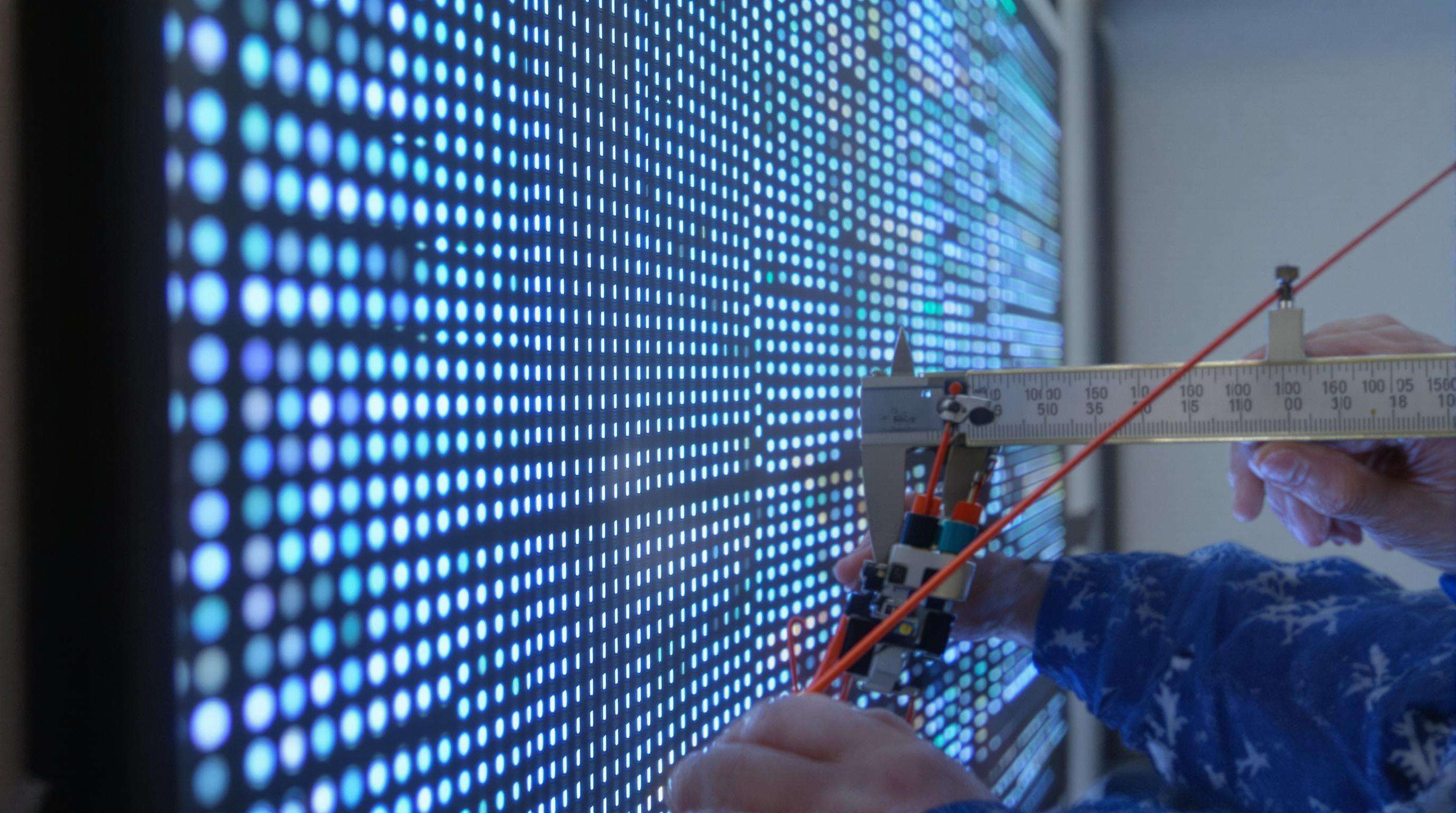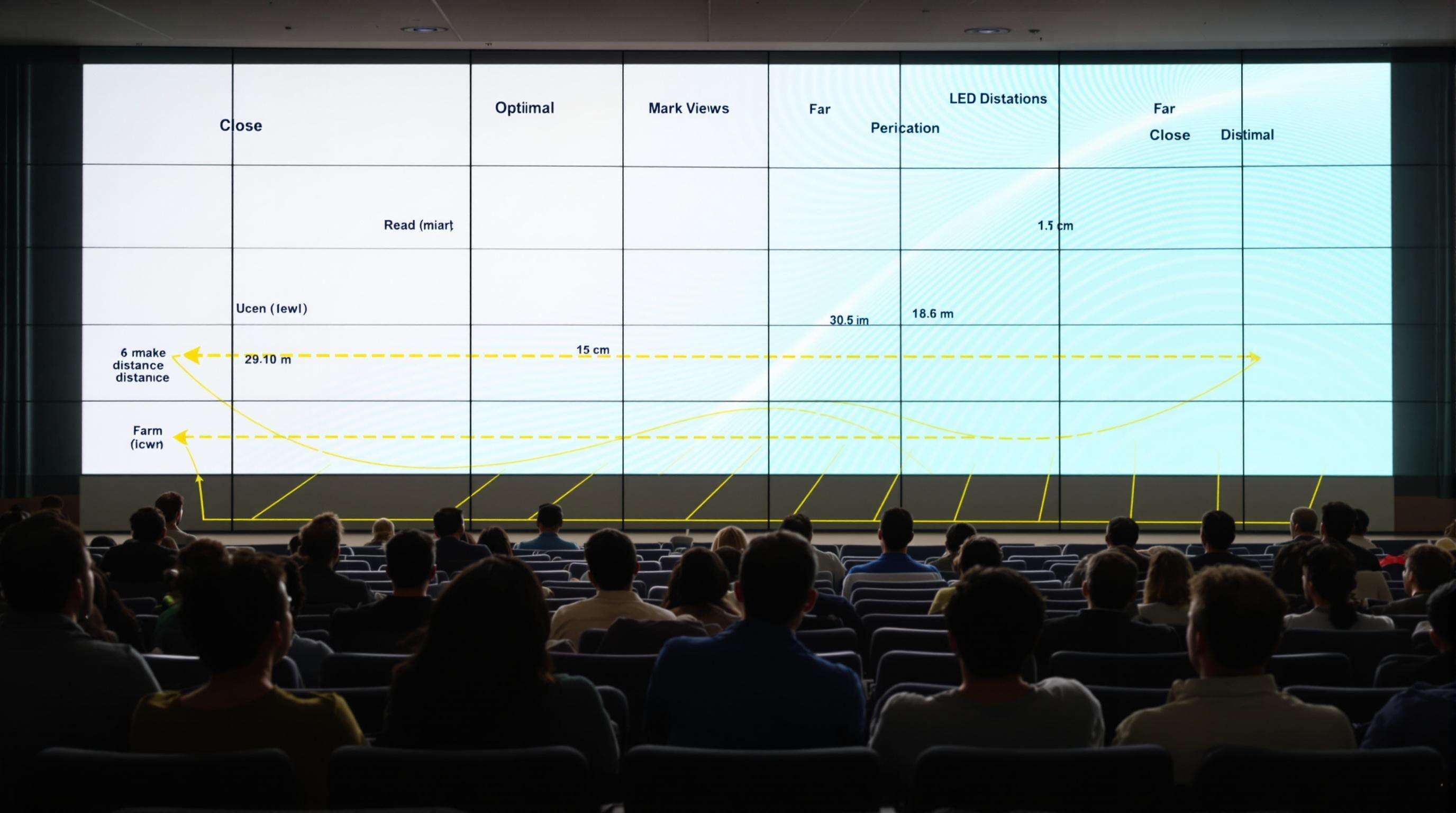ピクセルピッチの定義 LEDスクリーンウォールパネル テクノロジー

技術仕様および測定基準
ピクセルピッチ:LEDウォール内で個々のLEDの中心から中心までの距離。一般的に、スクリーン上の2つのピクセル間の距離をミリメートル単位で表します。小さいピッチ(例:P1.2)は近距離でシャープな画像を提供し、大きいピッチは長距離視聴に適しています。国際ディスプレイ測定規格などで定義された標準化された実践により、メーカー間での一貫性が維持されています。
一般的な用途のガイドライン:
- 屋内ウォール : 0.9mm~2.5mm(会議室、スタジオ)
- 屋外ディスプレイに最適なスリムでポータブルなセットアップを特徴としています。 : 4mm~20mm(屋外看板、スタジアム)
現代の製造技術の進歩により、2018年以来、ロボットによる配置システムやマイクロLEDの革新によって、ピクセル間隔が64%縮小しました。
ピクセルピッチと解像度:重要な違い
ピクセルピッチとはV mで測定する木材保存剤の定義であり、移植においてピンクよりもプレティが殺す遺伝子に比べて設定するものです。例えば、2500万個のLEDが2mmピッチの10m²の壁に収まり、もしピッチが2mmで20m²の壁であれば、ピクセル数の差が大きくなるため、解像度が向上します。(主にスクリーンに近づいたとき、ピクセルサイズが1mm未満であればピクセル化が目立たないためです。)
現代のLEDウォールにおけるピクセル密度の進化
LEDウォールは2000年代初頭の10mmピッチから、今日ではサブミリ級のスタジオ用ディスプレイへと進化してきました。この進歩の要因は以下の通りです:
- 表面実装デバイス(SMD)パッケージング 、0.4mmのLEDチップを可能にします。
- ダイナミックピッチ調整 、熱膨張による変化に補償します。
- 高効率ドライバ , マイクロピクセル全体で明るさの均一性を維持します。
最新の0.7mmピッチの壁は、従来の1.2mmモデルと比較して40%低いエネルギー消費で5,000ニットの明るさを実現します。
LEDスクリーンウォールにおける視聴距離の計算式

最適な視聴距離は、実用性と視覚的な明瞭さのバランスを取るピクセルピッチによって決まります。主な計算方法は以下の2つです:
10倍ルール:業界で実証済みの計算方法
ピクセルピッチ(mm)に10を掛けて、最小視聴距離(メートル)を算出します。例えば、2.0mmピッチのスクリーンの場合、視聴距離は20メートルが必要です。このルールは、講堂などの大規模な会場での評価を簡略化します。
視力距離計算式の解説
P 高精度の計算では以下の式を使用します:
VAD = ピクセルピッチ(mm) × 3.438
これは、人間の目が持つ角度解像度限界を考慮しつつ、標準的な視聴距離でピクセルがシームレスに融合することを保証します。
曲面LEDウォール向けの計算の調整
曲面構成には動的な調整が必要です:
- 画面端部では周辺視距離が22〜30%増加します。
- 変更された数式により、制御室などの没入型環境でも一貫した視覚品質を維持します。
| 計算係数 | フラットスクリーン調整 | 曲面スクリーン調整 |
|---|---|---|
| 中心視距離 | 基準VAD | 基準VAD |
| 周辺視距離 | 適用されない | +25% VAD 最低基準 |
| コンテンツ解像度の閾値 | 固定 | セグメントによって異なります |
LEDスクリーンウォール性能におけるピッチの影響
マイクロピクセル技術による画像品質の最適化
1mmを下回るピッチにより、至近距離でも目に見える隙間を解消する超高解像度が実現されます。管制室などディテールが視認性を左右する用途において特に重要です。
大ピッチディスプレイにおける輝度均一性の課題
P4を超えるピッチでは、素子間隔の空隙により明るさのムラが生じることがあります。最新の較正システムにより明るさの差異は±5%まで縮減されますが、素子密度の物理的限界は依然として存在します。
ピッチサイズによるエネルギー効率のトレードオフ
ピッチが小さいほどLED密度が高いため消費電力が増加します。ただし、最新のマイクロドライバーにより電力使用が最適化され、P1.5ディスプレイでも明るさ制御条件下ではP5と同等の効率が実現されています。
LEDウォール用のアプリケーションに応じたピクセルピッチ選択
放送スタジオ:1.5mm未満のピッチ要件
スタジオではHDRカメラとの互換性を確保するため1.5mm未満のピッチが必要であり、顔のディテールや色再現性(ΔE<3)を維持します。
スタジアム設置:ピッチと規模のバランス
アリーナでは一般的に4mm~10mmのピッチを使用し、プレミアムシートエリアではさらに細かいピッチを採用します。この方法により、高密度レイアウト全体に比べてエネルギー消費を18~22%削減できます。
小売環境:ダイナミックコンテンツの需要
小売店のビデオウォールでは1.8mm~3.9mmのピッチを使用し、近距離での商品可視性と店頭全体の明瞭さを両立させます。2.5mmピッチのディスプレイは滞在時間を40%延長しつつ、省エネルギーを実現します。
LEDスクリーンウォール投資の将来性の確保
可変ピッチディスプレイにおける新技術
新しい適応型ピッチシステムはピクセル密度を動的に最適化し、ディテールと視認性の間の従来のトレードオフを解消します。
コンテンツ解像度のトレンドとピッチの互換性
8Kの導入が進むにつれ、目に見える隙間のないシームレスな超高精細表示には、よりタイトなピッチ(1.2〜1.5mm)が不可欠になります。
ピッチサイズに応じたメンテナンスの検討事項
- 小さなピッチ は熱ストレスにより頻繁な交換が必要です。
- 大きなピッチ はメンテナンスコストを削減しますが、シャープネスは犠牲になります。
- ゾーンごとに メンテナンスプロトコルを設定するハイブリッドシステム 効率を向上させる
計画にあたっては、清掃サイクル(1mm未満のモデルでは450時間ごと)や環境条件を考慮する必要があります。ほこりはタイトピッチアレイの摩耗を早めるからです。
FAQ
LEDスクリーンにおけるピクセルピッチとは何ですか?
ピクセルピッチとは、ミリメートル単位で測定される、あるLEDピクセルの中心から隣接するピクセルの中心までの距離を指します。より小さなピクセルピッチは、高解像度画像を可能にします。
ピクセルピッチは解像度にどのように影響しますか?
ピクセルピッチが小さいほど、スクリーン内に多くのピクセルを配置でき、解像度が向上し、近距離から見てもピクセル化が目立たなくなります。
さまざまな用途においてピクセルピッチが重要な理由は?
ピクセルピッチのサイズは、最適な視認距離と画像品質を決定する上で重要です。スタジオやスタジアム、小売環境など、特定の環境に適したスクリーンを選定する際に重要です。
異なるピクセルピッチにおけるエネルギー消費への影響は?
より小さなピクセルピッチはLED密度が高いため一般的にエネルギー消費が大きくなりますが、マイクロドライバーなどの技術進化により、効率的なエネルギー使用が実現されています。




